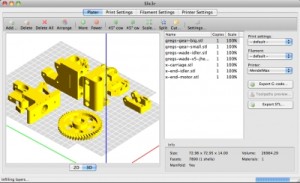The biggest challenge for any single aspect of the 3D printing industry is trying to unify and standardize its many faces. In my opinion, there is not, and there has never been, an industrial sector that touches upon so many different fields and aspects of society, with hundreds of social, industrial and environmental implications. Analysts and journalists try to catalogue and connect all these aspects into common trends and threads: materials and material families, 3D scanners and 3D scanning technologies, 3D printers and 3D printing technologies, applications, software, services, shops and so on.
Software developers, on the other hand, try to create platforms to enable all these different aspects to work together, connect with each other, controlling and even exploiting these differences. Slic3r did it for RepRap 3D printers, becoming the one software than can make pretty much all of them run, while greatly reducing the cost of access to a 3D printer and simplifying the process at the same time.
Although I have often argued that Italians have their main strength in creativity, design and familiarity with mechanical systems, while they generally lack the ability to code and create powerful software, the most popular software in the young and rapidly evolving open source 3D printing community was invented by an Italian: Alessandro Ranellucci. His case is not the only one but it is a rarity on the software development scene and, like all exceptions, it seems to counter-intuitively go to show that failing to adequately teach software literacy in Italian schools favours the rise of self-taught technological visionaries.

He is also an architect, partner of the Supervisione dell’Architettura studio, and has been developing open source software for more than ten years: these last two passions (he is also a fan of sailing in his remaining spare time, he tells me) combined to drive him to start the Slic3r project. “As an architect I became interested in 3D printing as a way to create physical models of my designs,” he says. “While looking for ways to reduce the extreme costs of professional prototyping I found out about the RepRap project but I also found that many of those machines did not work like I wanted them to.”
In 2011 Ranellucci decided to go to work on it and began studying and developing the software to make the 3D printers work like they should. “I created the first version of Slic3r and published it on the web. People immediately contacted me to tell me they found it very interesting, they gave me suggestions and encouraged me to continue. Then they started adding new functions but the most amazing thing was when I started receiving financial contributions from those who told me I had helped them solve some issues.”
Alessandro seems both very proud, that someone would go as far as contributing financially to this project, and very humbled by it. He stresses that Slic3r is not envisioned to be a business but he is fully aware that the financial contributions are what makes it possible for him and the other developers in the community – which include both the main developers and a few hundred active users who test it and give feedback on it on GitHub – to continue to improve it and enable it to cater to the evolving needs of a community that is roughly estimated to include about 250,000 3D printers.
“This is a project so much larger than what I would have ever been able to do on my own,” Ranellucci says. “Slic3r works on all the open 3D printers and on most MakerBots too. It can also be used on SLS and DLP printers as well”. It seems strange at first but Alessandro explained to me that the geometrical calculations necessary to make a file printable on an FFF RepRap machines are much more complex than what is required for professional grade stereolithography and laser sintering. Supports, infills and internal structure all add up to make the slicing algorithms up to 95% more complex.

Ranellucci is now part of global community of open source software (and hardware) developers and visionaries that have embraced the open source model. He does this for a passion, in addition to his other activities, and my impression is that he is fully aware that open source and closed systems need to be able to coexist. At the same time he is fully aware that having an entire global community collectively contribute to the development of one project to help many can be more personally rewarding.
Working as director of the Make in Italy Foundation, which also includes Arduino’s founder Massimo Banzi as president, Ranellucci, like many other successful self-made entrepreneurs, hopes that his story can be an example to other young Italians and makers, showing them that with enough work and passion no objective is beyond reach. My own personal opinion is that the real problem in Italy is not the lack of exceptional talents as much as it is the total lack of regular people becoming successful through a scholastic system that can help them self actualize. One man cannot do it all, but hopefully, Ranellucci’s intensive and continued efforts will contribute to address this issue as well.


